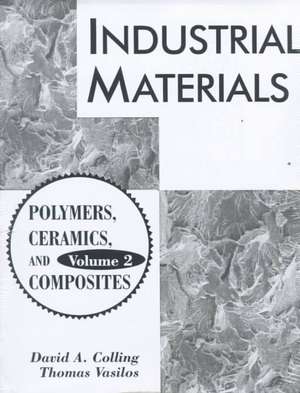Industrial Materials: Volume 2, Polymers, Ceramics and Composites
Autor David A. Colling Thomas Vasilosen Limba Engleză Paperback – 28 feb 1995
This practical introduction to polymers, ceramics, and composites gives students the background they need to make optimal use of materials in a variety of manufacturing applications. The text's logical organization presents a wealth of information...along with case studies that provide realistic problem-solving situations involving actual industrial applications. Rather than focus on teaching computational skills or theoretical knowledge, it concentrates on imparting an understanding of how and when materials are used. Coverage examines specific applications and their requirements and relates those requirements to the properties of various materials, illustrating criteria for appropriate materials selection and techniques for maintaining control over materials properties during processing.
Preț: 708.61 lei
Preț vechi: 920.28 lei
-23% Nou
Puncte Express: 1063
Preț estimativ în valută:
135.61€ • 140.09$ • 112.86£
135.61€ • 140.09$ • 112.86£
Carte indisponibilă temporar
Doresc să fiu notificat când acest titlu va fi disponibil:
Se trimite...
Preluare comenzi: 021 569.72.76
Specificații
ISBN-13: 9780023235535
ISBN-10: 0023235535
Pagini: 256
Dimensiuni: 185 x 234 x 11 mm
Greutate: 0.39 kg
Ediția:1
Editura: Pearson Education
Locul publicării:Upper Saddle River, United States
ISBN-10: 0023235535
Pagini: 256
Dimensiuni: 185 x 234 x 11 mm
Greutate: 0.39 kg
Ediția:1
Editura: Pearson Education
Locul publicării:Upper Saddle River, United States
Cuprins
1. Properties of Non-Metallic Materials and Composites.
2. Polymer Materials.
3. Polymer Processing.
4. Crystalline Ceramic Materials.
5. Glass.
6. Ceramics Processing.
7. Composite Materials.
8. Processing of Fiber Reinforced Composite Materials.
9. Concrete.
10. Wood and Wood Products.
Index.
Caracteristici
- The text's qualitative rather than quantitative approach to its subject, focuses attention on the practical aspects of manufacturing materials as they are encountered in the “real world.”
- Mathematics is limited to the basics needed for understanding concepts.
- Numerous real examples, taken from actual industrial applications, provide hands-on experience in problem-solving.
- A wealth of case studies throughout the text illustrates the real decision-making and problem-solving related to industrial applications.
- Mathematics is limited to the basics needed for understanding concepts.
- The practical, realistic topic treatment is enhanced by the inclusion of dozens of original microstructural and scanning electron micrographs depicting specific properties of materials, the effects of mechanical and thermal processing, and the tell-tale signs of defects.
- Thorough, full-chapter treatment of concrete and wood provide a comprehensive look at these often-employed materials...materials which lead all others in annual consumption.
- Coverage of the creation of composites includes discussion of both established techniques and the latest technologically-advanced tools.
- An extensive glossary helps students learn the nomenclature of the field.
